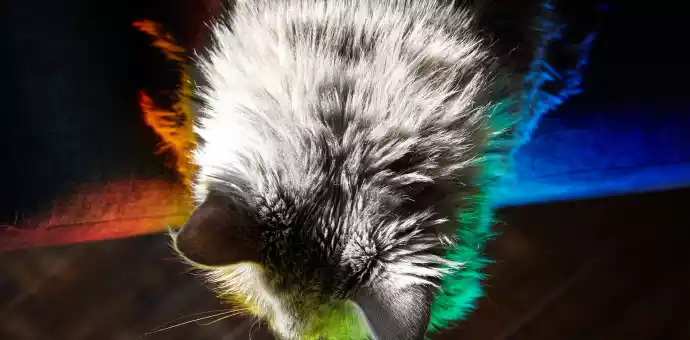[rank_math_breadcrumb]
Yes, cats can see color, but they perceive it differently than humans. Cats have dichromatic vision, which means they see a more limited range of colors than humans. Let’s delve deeper into the intriguing world of cat vision and investigate “Can cats see color” and how they perceive their surroundings.
[toc]
Understanding Feline Eye Anatomy
To understand how cats see color, you must first understand their eye architecture. Cats’ eyes are complex and developed for both day and night vision. Their eyes comprise several components that help them traverse their surroundings and hunt efficiently.
Cats with large, almond-shaped eyes have a broad range of vision. They can detect movement more effectively due to their wider field of view, around 200 degrees compared to our 180 degrees. Their eyes are in front of their heads, giving them binocular vision and depth perception.
What Exactly Is Color Blindness?
Color blindness is defined as the inability to recognize or distinguish between specific colors. While humans can suffer from color blindness, cats do not. Color blindness refers to feline vision’s reduced perception of colors compared to humans.
Color blindness is frequently caused by the lack or failure of certain cone cells that sense specific wavelengths of light in humans. Cats have two types of cone cells instead of the three types found in humans, known as dichromatic color vision. This variation in cone cells impairs their capacity to differentiate between different colors.

How Do We Know Cats Aren’t Color Blind?
Scientific research has demonstrated that cats are not entirely color-blind. Researchers have learned about the presence of specialized cells called cones that detect different wavelengths of light by researching the architecture of their eyes.
This shows that cats, like humans, can sense colors, albeit in a more limited range. A study at the University of California, Santa Barbara, discovered that cats’ retinas had a high density of blue-sensitive cones.
These cones enable them to perceive blue more effectively. While cats may not see the same colors as humans, their ability to discern blues and distinguish between hues of blue suggests color vision.
Can Cats See Colors?
Now that we know cats are not colorblind let us investigate their color vision abilities further. They can see colors, but their palette is more muted than ours. The world appears in diverse blues and yellows to cats, with little distinction between reds and greens.
The blue and violet colors of cats’ vision are the most sensitive. They can distinguish between distinct tints of these colors more successfully than others. On the other hand, they have trouble discriminating between reds and greens, which may seem like a similar shade of yellowish-grey.

What Colors Can Cats See?
Cats have a narrower color spectrum than humans. Shorter wavelengths, like blues and violets, are particularly sensitive to their vision. They sense these colors more vividly and can distinguish between different tones of blue.
However, they have difficulty distinguishing between reds and greens since these colors can look to them as a similar shade of yellowish-grey.
How Can Cats See Color?
Cats perceive color through specialized cone cells that detect different wavelengths of light. Cats only have two types of cones, compared to three for humans (red, green, and blue). Compared to our trichromatic vision, their dichromatic vision reduces their color perception.
Blue-sensitive cones in a cat’s eyes help them to see blue more clearly. They can tell the difference between brilliant blue and violet colors. They can sense some colors of green thanks to green-sensitive cones, although not as vividly as humans.
Other elements, such as lighting and contrast, impact cats’ color vision. Instead of depending exclusively on color, they use tiny changes in brightness and patterns to distinguish between items.

What Colors Do Cats See the Best?
Blue and violet are the most vivid colors that cats can see. They see these colors as vibrant and can identify tiny changes between tints. Remembering that just because they can see specific colors doesn’t mean they see them the same way we do. Cats have a distinctive visual experience.
In their native environment, cats’ sensitivity to blue and violet hues is beneficial. For example, a bluebird against a green background would stand out more to a cat than a human. This visual advantage allows them to notice possible prey or detect movement efficiently.
Human Vision vs. Cat Vision: Can Cats See Color?
Color perception abilities differ significantly between humans and cats. Thanks to their trichromatic vision, humans can perceive various colors, including reds, greens, blues, and many others. Cats perceive the world mainly in blues and yellows due to their dichromatic vision, which has a limited range.
Let’s compare human’s and cats’ color sense to grasp the differences better:
| Aspect | Humans | Cats |
| Number of Cone Types | Three: Red, Green, and Blue | Two: Blue, Green |
| Color Perception Range | Broad spectrum from red to violet | Limited spectrum focused on blues and yellows |
| Sensitivity to Red/Green | Sensitive to both red and green wavelengths | Less sensitive to red and green wavelengths |
Humans have a broader color vision spectrum, allowing us to enjoy the complexities and nuances of the world’s bright colors. On the other hand, cats have adapted to their surroundings by developing more specialized color vision, which aids in hunting and survival.

What Other Visual Deferences Exist Between Cats and Humans?
Aside from color vision, cats and humans have several additional visual differences. These distinctions are the outcome of various evolutionary adaptations to their respective lifestyles.
Vision Nutrition
Provide a balanced diet rich in essential nutrients, including antioxidants like vitamins A, C, and E.
Sight Exercise for Cats
Engage your cat in interactive play sessions stimulating their visual acuity and coordination.
Regular Eye Cleaning
Gently clean your cat’s eyes to remove debris and prevent infections.
Annual Vet Exams
Schedule regular veterinary check-ups to monitor overall health and detect potential vision issues.

Night Vision
Cats have better night vision than humans. Their eyes have evolved to be more sensitive to low-light settings, letting them can see more clearly in the dark.
The tapetum lucidum, the reflecting layer below their retina, and the many rod cells in their eyes improve their capacity to detect motion and navigate in low-light conditions.
Field of View
Cats have a more extensive range of views than humans, which helps them with their hunting instincts. While humans have a field of vision of about 180 degrees, cats can see up to 200 degrees.
Because of their wider field of vision, they can detect movement from the sides more effectively, making them great predators.
Focus and Depth Awareness
Cats have great focus and depth awareness thanks to their forward-facing eyes. Their eyes are in front of their heads, giving them binocular vision. Binocular vision allows them to evaluate distances effectively, essential when pouncing on prey.

How Far Can Cats See?
Cats have excellent visual acuity and can perceive objects from a distance. Cats can see up to 100 to 200 feet away, on average. This superior distant vision benefits their hunting instincts by helping them to locate possible prey or detect potential hazards from a distance.
Cats’ excellent eyesight and ability to focus on little details help them perceive objects at a distance. Their eyes are built to detect motion and track objects, allowing them to track prey or potential dangers visually.
Is it True That Cats Have Night Vision?
The ability to see in the dark is a strength that is unmatched by any other. Their eyes have modifications that let them see in low-light situations. The previously described tapetum lucidum reflects light through the retina, magnifying the available light.
This and their many rod cells offer them an edge while navigating and hunting in low-light conditions. The tapetum lucidum is a “light amplifier by bouncing incoming light back through the retina.”
This amplification lets cats make the most of the available light, considerably improving their night vision. It’s worth mentioning that their night vision isn’t completely black and white but a subdued version of their color vision during the day.

Is it Possible For a Cat to Have Bad Eyesight?
Contrary to popular belief, a cat’s eyesight is not naturally poor. Their visual system is tuned to their surroundings, allowing them to excel in various lighting settings. The only way to know for sure is to try it yourself.
Regular monitoring and veterinary examinations are essential for keeping their vision healthy. While cats’ visual abilities differ from those of humans, it is critical to recognize that their eyesight is highly adapted to their lifestyle.
Their eyes are built to hunt, navigate, and survive in various illumination settings, including low-light environments.
How Can I Support My Cat’s Vision?
Maintaining your cat’s vision health is critical to their overall wellness. Here are some pointers to help them improve their visual abilities:
Vision Nutrition
Proper nutrition is critical in maintaining your cat’s vision health. The health of your eyes depends on how well you care for them. Vitamin A, in particular, is essential for excellent vision. It promotes retinal health and aids with low-light vision.
Incorporating high-quality commercial cat food developed to promote eye health is a bright place to start. These meals are frequently supplemented with the vitamins and minerals required for good vision. Consult your veterinarian, however, to ensure that you provide the proper nourishment for your cat’s needs.

Cat Vision Training
Regular sight activities for your cat can assist in boosting their visual acuity and maintain their eyes bright. Interactive play sessions with moving toys or laser pointers can be practical. These exercises encourage hunting behavior in your cat, helping it to focus, track, and pounce on a moving object.
Additionally, giving vertical locations for your cats, such as cat trees or shelves, encourages them to practice their climbing and jumping skills. This activity suits their physical health and helps them develop their depth perception and coordination.
Regular Eye Cleaning
Maintaining good cleanliness around your cat’s eyes is critical to prevent eye disorders. Check for discharge, crust, or debris around their eyes regularly. Use a soft, wet cloth or specialized eye wipes to clean their eyes if you observe any buildup gently.
Avoid touching the eyeball directly; use solid chemicals or treatments only if your physician recommends it. Regular eye cleaning helps avoid infections and allows you to keep track of any changes in look or behavior.
You must seek veterinarian care if you observe any chronic problems, like redness, excessive tearing, or squinting.
Annual Vet Checkups
Annual veterinary examinations are required to protect your cat’s overall health and vision. The veterinarian will thoroughly inspect your cat’s eyes throughout these checks, looking for any symptoms of abnormalities or underlying diseases.
They may provide particular tests to assess your cat’s visual acuity, such as tracking moving objects or analyzing their reaction to light. Regular veterinary exams aid in the early detection of vision-related disorders, allowing for rapid treatment and management.
The veterinarian can also provide personalized advice on keeping your cat’s vision healthy, depending on their specific demands.

Keeping Your Cat’s Vision Health in Mind
Incorporating these activities into your cat’s everyday routine can assist in keeping their vision in good condition. Remember to watch for changes in their behavior or visual abilities and visit a veterinarian if you have any concerns.
You contribute to their overall happiness and quality of life by emphasizing their vision of health. Maintaining a healthy lifestyle, giving a proper diet, engaging in frequent sight exercises, and seeking competent veterinarian care are all critical for your cat’s vision health.
Key Takeaways
- Cats can detect colors. However, their color vision is less developed than that of humans.
- Cats have dichromatic vision, meaning they see primarily blues and yellows.
- They can see best in blue and violet hues.
- Cats have enhanced night vision due to eye structural modifications.
- A nutritious diet and regular veterinary check-ups are essential for sustaining vision health.
Conclusion
While cats can not see the world in the same brilliant colors as humans, they have unique visual abilities that suit their evolutionary demands.
Understanding how cats perceive color and their visual abilities allows us to understand their fantastic worldview.
We can ensure that our feline friends continue to live bright and visually stimulating life by offering proper care and attention to their vision health.
What do cats see when they look at humans?
What colors can cats not see?
Can cats see red?
Can cats see pink?
What colors do cats see best?
Can cats see blue?
What three colors can cats see?
“Be Petspaa, Do PetsPaa”
Can Cats Eat Crab? Exploring Feline Cravings & Safety
Can Cats Eat Cheese? You Need to Know First
Can Cats Eat Strawberries? Unveiling the Sweet Truth







